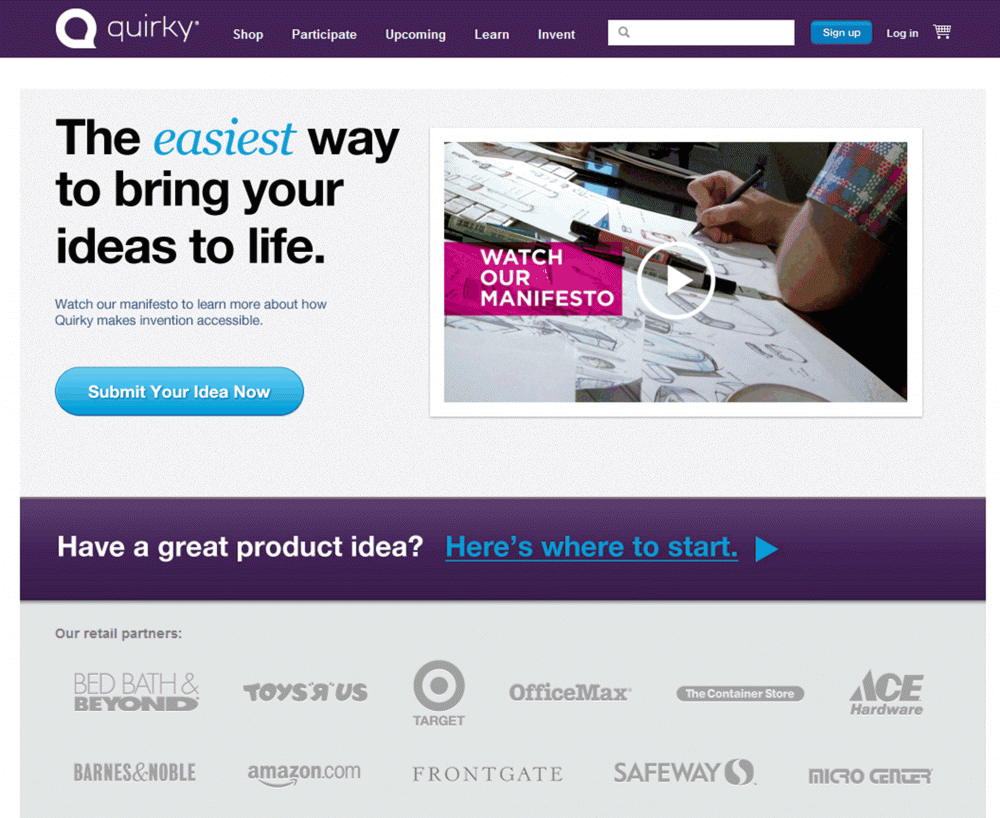By: Doug Collins
Established firms in the media & entertainment space struggle to prosper in the Digital Age. New business models, enlivened by technology, erode traditional sources of profit. What possibilities for reimagining the business exist? In this article, innovation architect Doug Collins suggests one avenue to pursue: consider the benefits that come from learning how to convene a community on the critical question by embracing the practice of collaborative innovation. Apply the practice to help people work to their potential.
We live in 2012. Last month a friend of a friend, who once slaved at the HBO company of Time Warner in the U.S., informed me that he planned to make a movie. He offered various incentives for people to invest in his venture on Kickstarter (figure 1). Being a fan of the movies, liking him, and never having experienced “green lighting” a film, I contributed $100.
This man raised the funds he needed. As a result, I get invited to the release party to watch the movie. You can believe I will watch the movie. I have invested myself in its success.
From what I can see, a lot of tyro producers seek funding for their shorts and movies on Kickstarter. As I recall, this means of funding and followership—crowd funding—did not exist 600 days ago in 2010.
Figure 1: the author as mini-mogul–the project home on Kickstarter
In March a tornado churned through Dallas, Texas. A couple colleagues who live in the Lone Star State reported hunkering down in their basements. Concerned and curious, I logged into my Twitter account. I saw #dallastornado trending. I selected the hash tag and, for a time, immersed myself in the commentary and meta-commentary on the force and direction of the storm. People in Dallas uploaded pictures and videos of the tornado as it approached them.
Six hundred days ago I would have checked CNN.com or the Weather Channel. I wonder whether the people who run Twitter consider themselves a media business. The distinction may not concern them. As a consumer I do not care. I suspect the traditional news business does care, however. My attention went to Twitter, not them.
What Happened?
Two waves wash over the world of the incumbent media & entertainment company: the world moved from single-channel broadcast to multi-service engagement. And, the money went elsewhere.
Up until 1990s the world subsisted on discrete channels sending content by a schedule (figure 2).
Figure 2: the way we were
At some point web-based content distribution proliferated. The web opened the possibility for authentic engagement: engagement between producer and viewer and engagement between viewers, worldwide. I could tweet to the cellar dwellers in Dallas.
Viewers became producers, too. Internet or web-based television piggybacked on mobile with the proliferation of smart devices and never looked back. Passive viewing leaped to user production and, per my ex-HBO’er friend once removed, user funding (figure 3).
Figure 3: the viewer as creator
The financial model and the financial power shifted, too. Apple and Google, ostensibly focused on technology, command larger and larger shares of the media & entertainment revenue pie. Incumbents complain the new regime offers cents on the dollar, relative to the model based on the 30-second ad. Companies such as The Procter & Gamble Company, which put the soap in soap operas, send shots across the bow by declaring they will dedicate bigger chunks of their advertising budget to “digital.”
What now?
To say that the digital age has disrupted the media & entertainment industry would be an understatement. The business model based on the 30-second ad has become an exercise in savage reductionism: nobody leaves whole.
To understand what the future can hold for the incumbent media & entertainment space—a way forward—it is helpful to look at the technology companies that are usurping them by either design or chance. What strengths do they enjoy?
Speed and Openness
The presence of pure-play digital technology companies in this space collapses the rate of technological turnover from ten years to five years to less. The rate of change speeds in the consumer space, in particular. It’s now under a year.
The most successful firms in this space have embraced openness by embracing a platform strategy. By definition, people who pursue this strategy commit to developing a space—a marketplace—where participating benefits all parties. Apple has created this space with iTunes. Twitter has done the same with its approach, as has Kickstarter. The fact that they attracted rich media content happened because the community saw sharing pictures and videos as yet another dimension to engagement.
Where does the incumbent media & entertainment firm start, then? Creating the equivalent of a Twitter or Kickstarter in house seems unlikely. In the near term, it is.
A Way Forward
One path forward is to embrace the behaviors and disciplines that have made these firms successful and have enabled them to develop a culture of innovation based on speed and openness. Incumbent players in media & entertainment can begin to do so, in particular, by embracing the practice of collaborative innovation. By collaborative innovation I mean the practice by which organizations engage people within and outside their walls on the critical questions that confront them (figure 4).
Figure 4: defining the collaborative innovation space
Many, many organizations—including those that pride themselves on their innovation prowess—have cried the metaphorical “uncle” and opened their challenges to the world at large. The Procter & Gamble Company, for example, assessed that for every PhD chemist they employ, hundreds of their colleagues work outside their gates. The company realized authentic transformation as they perceived these external parties as a source of innovation.
What If?
What if a media & entertainment firm with production capabilities crowd-sourced ideas for their next feature? What if they offered points—or some form of engagement—in exchange for crowd funding?
Media & entertainment executives may want to see Quirky as a point of reference (figure 5).
Figure 5: Quirky as a point of reference
This firm has taken industrial design and merchandising to the next level by crowd-funding consumer products. Contributors whose ideas resonate with the community and with Quirky—and whose products sell—get a cut of the profits. What possibilities exist for a studio to pursue this approach with digital content? What price authentic engagement?
Looking inward we find, with rare exception, few traditional media & entertainment firms working as hotbeds of collaborative innovation. The functions remained silo’d. The budgetary processes reinforce established behaviors and hierarchies.
Internally, the practice offers the possibility for greater speed through improved process efficiency and more agile sharing of content. Interestingly, one of the biggest on-going challenges that media & entertainment companies face is the inability to put their hands on their own content. What do they own?
While indexing schemes and redundant storage makes sense, so, too, does enabling associates to ask across a brand, property, or enterprise: How might we leverage what we have to engage new audiences?
Knowledge management brought a new appreciation for tacit knowledge 15 years ago. It’s time now to realize that promise—not by treating people as information-laden vessels, but by phrasing the critical questions in a way that engages them and enables them to work to their fullest abilities.
The End Game
In closing, some organizations excel in helping their people realize their potential for leadership as they pursue the collaborative charter. The better firms, who set the pace, have found a way to sustain a speed and maintain openness.
Media & entertainment firms looking for that edge—that opportunity to survive—should consider exploring the possibilities that the practice of collaborative innovation offers to realize that goal. Start by asking the critical question: What does it mean for my organization to help people realize their potential for leadership through the practice of collaborative innovation?
By Doug Collins
About the author:
 Doug Collins is an Innovation Architect who has specialized in the fuzzy front end of innovation for over 15 years. He has served a variety of roles in helping organizations navigate the fuzzy front end by creating forums, venues, and approaches where the group can convene to explore the critical question.
Doug Collins is an Innovation Architect who has specialized in the fuzzy front end of innovation for over 15 years. He has served a variety of roles in helping organizations navigate the fuzzy front end by creating forums, venues, and approaches where the group can convene to explore the critical question.
As an author, Doug explores the critical questions relating to innovation in his book Innovation Architecture, Practical Approaches to Theory, Collaboration and Implementation. The book offers a blueprint for collaborative innovation. His bi-weekly column appears in the publication Innovation Management.





